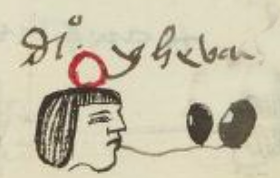Ehua (MH839r)
This black-line drawing of the simplex glyph for the personal name Ehua (perhaps “Possessor of Beans” or “He is Brave and Rebels”) is attested here as a man’s name. The glyph shows a frontal view of two black beans with little white spots. They are standing on end.
Stephanie Wood
The hieroglyph emphasizes beans (etl). To have beans is to have (-hua) one of the basic necessities of life (food). Hence, this is a possible translation. But the gloss is ambiguous. The expression might be a phonetic indicator for ehua (he departs, or he is brave and rebels), yehua (a little while ago), or yehuatl (he, she, or that person). The letters “e” and “y” often combine intentionally and inadvertently, where, for example, “e,” “eyi,” and “yei” can all mean “three.” In various examples below, where beans (etl) are elements in hieroglyphs, their use is often phonetic (simply -e-).
Stephanie Wood
dio
Diego Ehua
Stephanie Wood
1560
Jeff Haskett-Wood
frijoles, posesión, numbers de hombres

e(tl), beans, https://nahuatl.wired-humanities.org/content/etl
-hua (possessive), has, https://nahuatl.wired-humanities.org/content/hua
-i (singular third person possessive), his/her/its, https://nahuatl.wired-humanities.org/content/i
yehuatl (third person pronoun), https://nahuatl.wired-humanities.org/content/yehuatl
yehua, a little while ago, https://nahuatl.wired-humanities.org/content/yehua
Poseedor de Frijoles
Stephanie Wood
Matrícula de Huexotzinco, folio 839r, World Digital Library, https://www.loc.gov/resource/gdcwdl.wdl_15282/?sp=752&st=image.
This manuscript is hosted by the Library of Congress and the World Digital Library; used here with the Creative Commons, “Attribution-NonCommercial-ShareAlike 3.0 License” (CC-BY-NC-SAq 3.0).







